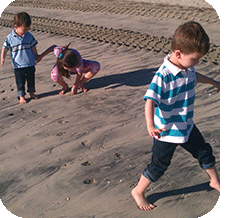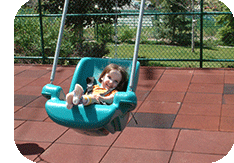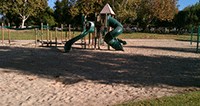Sensory Diets in Outdoor Play Environments
Author: Chad Kennedy, Landscape Architect, ASLA
 During a recent trip to the sunny beaches of San Diego, California I watched my three children closely as they interacted with the salty ocean water and the silky smooth sand. I am constantly amazed at the differences between each of them and their distinct individual actions at the beach were no surprise. The oldest, methodically traveled the beach, fascinated with the textures and colors of the many seashells and with the spongy qualities of the sand as evidenced in the depth of her footprints. The middle child was timid and tiptoed across the sand trying, futile as it was, to avoid as much skin to sand contact as possible. The youngest ran across the sand to the water's edge jumping, tripping, rolling and splashing without reservation and continued with messy, wet play for hours. At the core of these different approaches to the beach (play environment) lays the concept of acceptable sensory stimulation limits. Each child had separate and distinct sensory stimulation needs and they each found their own way of meeting them. The middle child was self-regulating his sensory stimulation by minimizing the sensations of sand pressing against his skin. The youngest however was experiencing the other side of the spectrum as his sensory needs at the time were oriented around more extremes with fast movements, cold water and compression sensations. Occupational therapists are keenly aware of sensory needs and often use the term "sensory diet" to describe a customized plan of sensory inputs or activities ordered in such a way to provide children with opportunities to fulfill or manage their internal stimulation quota.2 Though not commonly discussed in relation to many children's outdoor play environments, I propose that "sensory diets" whether formal or personally regulated should be a key component of any planned play environment.
During a recent trip to the sunny beaches of San Diego, California I watched my three children closely as they interacted with the salty ocean water and the silky smooth sand. I am constantly amazed at the differences between each of them and their distinct individual actions at the beach were no surprise. The oldest, methodically traveled the beach, fascinated with the textures and colors of the many seashells and with the spongy qualities of the sand as evidenced in the depth of her footprints. The middle child was timid and tiptoed across the sand trying, futile as it was, to avoid as much skin to sand contact as possible. The youngest ran across the sand to the water's edge jumping, tripping, rolling and splashing without reservation and continued with messy, wet play for hours. At the core of these different approaches to the beach (play environment) lays the concept of acceptable sensory stimulation limits. Each child had separate and distinct sensory stimulation needs and they each found their own way of meeting them. The middle child was self-regulating his sensory stimulation by minimizing the sensations of sand pressing against his skin. The youngest however was experiencing the other side of the spectrum as his sensory needs at the time were oriented around more extremes with fast movements, cold water and compression sensations. Occupational therapists are keenly aware of sensory needs and often use the term "sensory diet" to describe a customized plan of sensory inputs or activities ordered in such a way to provide children with opportunities to fulfill or manage their internal stimulation quota.2 Though not commonly discussed in relation to many children's outdoor play environments, I propose that "sensory diets" whether formal or personally regulated should be a key component of any planned play environment.
Sensory Diets
We often think of the senses as separate inputs (sight, touch, smell, sound, taste, vestibular or proprioceptive). In reality however, the senses are integrated systems that overlap and sometimes conflict with each other. In many children, the conflicts are quickly processed and adjusted for. In some cases children have more difficulty processing the complex nature of overlapping senses and coping with them.4 The result is often a display of behaviors reflected in an inability to cope. Recognizing sensory stressors and subsequently discovering strategies to overcome them is essential.
"Self-knowledge about sensory processing is empowering as sensory processing preferences can explain an individual's response to particular environments, situations, activities, and people. Furthermore, individuals can establish coping strategies and select activities based on an understanding of sensory processing by creating or pursuing environments that best match those preferences."1
The premise of a sensory diet is to control sensory inputs to regulate functioning and attention as well as to reduce sensory defense behaviors. The goal is not to instruct a child, but to modify their environment, activities, routines and interaction methods, in order to achieve sensory inputs that help the child self-regulate and adapt their behaviors or compensate for dysfunction.2 Sensory diets are integrated into a daily schedule spanning all aspects of a child's routine. Though sensory diets are typically a term associated with therapy strategies for children with sensory disabilities, every child and adult, whether aware of it or not, is continually adjusting and negotiating their own form of sensory diet as they change their behaviors based on environmental stimuli (seeking a quiet place to wind down, standing up to stretch, fidgeting during a meeting, etc.)
Implementation Methods for Sensory Integration
Sensory diets are more effective when families are actively engaged in directing a child's experiences during regular routines when not guided by therapists.3 Public outdoor spaces cannot feasibly be tailored to every child, however, a thoughtful designer can create spaces replete with intervention opportunities affording children and families the flexibility to create and enact personalized sensory routines outside controlled environments. Public playgrounds are examples of spaces that can be skillfully planned for such use.
Below are a few ideas about features to include or how to effectively provide for sensory diet implementation in public play spaces:
Add push / pull exercise equipment (vestibular / proprioceptive inputs
Add moveable objects to the space whether natural or manufactured to provide opportunities for lifting, pushing and pulling (vestibular / proprioceptive inputs)
Provide elevated and ground level items of interest to promote head movement in different directions (vestibular / proprioceptive inputs)
Add features with graduating levels of instability (vestibular / proprioceptive inputs)
Provide features that bounce or are springy (vestibular / proprioceptive inputs)
Add spinning and rocking features of varying heights and speeds (vestibular / proprioceptive inputs)
Design solid walls for bouncing, pushing and leaning against (vestibular / proprioceptive inputs)
Include a variety of swings. Bucket swings and disc swings are often preferred because of tendencies to let go of chains when over excited by movement stimuli (vestibular / proprioceptive inputs)
Hide objects in sand or other digging surfaces (tactile inputs)
Add water to the play environment (tactile inputs)
Vary texture on surfaces with similar and differing colors (tactile inputs)
Supply writing surfaces such as outdoor chalk and marker boards (tactile inputs)
Add a variety of hand gripping options, not just hooks (tactile inputs)
Design ample space on ramps and equipment for conflict free passing (cognitive inputs)
Create consistency in colors and organization patterns (cognitive inputs)
Incorporate spaces designated for simple games such as ball dribbling, ball throwing, jump roping, hopscotch etc. (Bilateral motor coordination)
Incorporate items with repetitive motion such as twirling, cranking, rolling etc. (visual, fine motor inputs)
Provide shaded play areas to avoid behaviors derived from inability to regulate body temperature
Separate noisy activities from more sedentary activities (auditory inputs)
Provide appropriate safety rails and barriers to minimize unperceived or perceived risks (insecurity inputs)
Limit the use of tunnels or confined spaces. When placed appropriately, however, they can provide secure areas for respite (Insecurity inputs)
Though the term "sensory diet" is not typically used in common conversation, it is nevertheless a principle that each of us experiences. Whether it is evidenced in a child tiptoeing across the sand or by a child emphatically splashing in cold ocean water the concept is the same, we each have sensory related needs to fulfill. With proper planning of our outdoor play environments, hopefully all children will be able to find ways to meet those needs, even while at play.
1.Tina Champagne and Edward Sayer. OT Innovations. http://www.ot-innovations.com/pdf_files/QI_STUDY_Sensory_Room.pdf Accessed December 2012.
2.Marie E. DiMatties and Jennifer H. Sammons. Understanding Sensory Integration. Asia-Pacific Childhood Disability Update. 2005.
3.Elizabeth Dunstan and Sian Griffiths. Sensory Strategies: Practical Support to Empower Families. New Zealand Journal of Occupational Therapy. 55(1):5-13. 2008.
4.Eide, Fernette. Sensory Irrigation - Current Concepts And Practical Implications. Sensory Integration Special Interest Section Quarterly. American Occupational Therapy Association. 26(3). September 2003.
5.Garcia, Tecla. Personal Interview. October 2013.
6.Nackley, L. Victoria. Sensory Diet Applications and Environmental Modifications: A Winning Combination. http://www.ateachabout.com/news/sensory_diet_applications_review.asp. 2001.
 During a recent trip to the sunny beaches of San Diego, California I watched my three children closely as they interacted with the salty ocean water and the silky smooth sand. I am constantly amazed at the differences between each of them and their distinct individual actions at the beach were no surprise. The oldest, methodically traveled the beach, fascinated with the textures and colors of the many seashells and with the spongy qualities of the sand as evidenced in the depth of her footprints. The middle child was timid and tiptoed across the sand trying, futile as it was, to avoid as much skin to sand contact as possible. The youngest ran across the sand to the water's edge jumping, tripping, rolling and splashing without reservation and continued with messy, wet play for hours. At the core of these different approaches to the beach (play environment) lays the concept of acceptable sensory stimulation limits. Each child had separate and distinct sensory stimulation needs and they each found their own way of meeting them. The middle child was self-regulating his sensory stimulation by minimizing the sensations of sand pressing against his skin. The youngest however was experiencing the other side of the spectrum as his sensory needs at the time were oriented around more extremes with fast movements, cold water and compression sensations. Occupational therapists are keenly aware of sensory needs and often use the term "sensory diet" to describe a customized plan of sensory inputs or activities ordered in such a way to provide children with opportunities to fulfill or manage their internal stimulation quota.2 Though not commonly discussed in relation to many children's outdoor play environments, I propose that "sensory diets" whether formal or personally regulated should be a key component of any planned play environment.
During a recent trip to the sunny beaches of San Diego, California I watched my three children closely as they interacted with the salty ocean water and the silky smooth sand. I am constantly amazed at the differences between each of them and their distinct individual actions at the beach were no surprise. The oldest, methodically traveled the beach, fascinated with the textures and colors of the many seashells and with the spongy qualities of the sand as evidenced in the depth of her footprints. The middle child was timid and tiptoed across the sand trying, futile as it was, to avoid as much skin to sand contact as possible. The youngest ran across the sand to the water's edge jumping, tripping, rolling and splashing without reservation and continued with messy, wet play for hours. At the core of these different approaches to the beach (play environment) lays the concept of acceptable sensory stimulation limits. Each child had separate and distinct sensory stimulation needs and they each found their own way of meeting them. The middle child was self-regulating his sensory stimulation by minimizing the sensations of sand pressing against his skin. The youngest however was experiencing the other side of the spectrum as his sensory needs at the time were oriented around more extremes with fast movements, cold water and compression sensations. Occupational therapists are keenly aware of sensory needs and often use the term "sensory diet" to describe a customized plan of sensory inputs or activities ordered in such a way to provide children with opportunities to fulfill or manage their internal stimulation quota.2 Though not commonly discussed in relation to many children's outdoor play environments, I propose that "sensory diets" whether formal or personally regulated should be a key component of any planned play environment.


